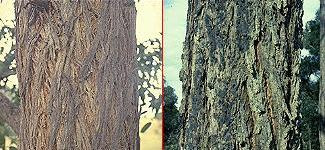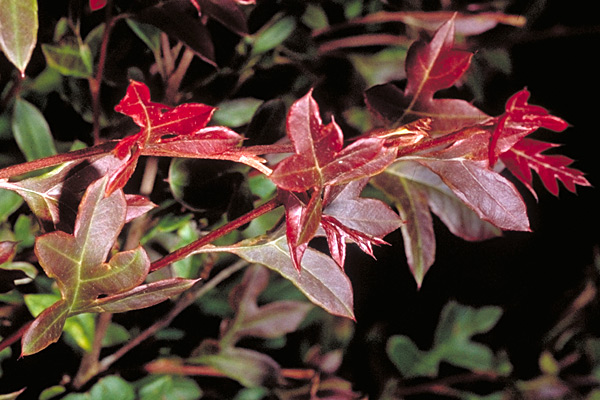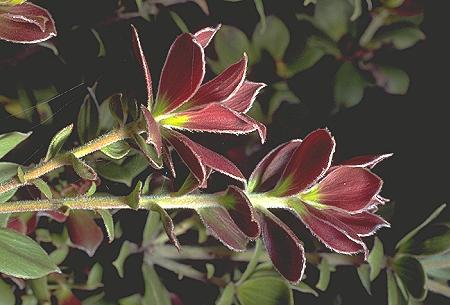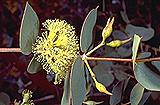|
[Front Page] [Features] [Departments] [Society Home] [Subscribe]

Textures and Forms of Australian Plants
Barrie Gallacher
Abstract
Form and texture are significant attributes to be considered when choosing plants for urban landscape use. Form or habit refers to the shape of a plant. There are many plant forms such as conical, columnar, round-headed, spreading, irregular, upright or prostrate. Plant texture refers to foliage character, either in describing the effect of massed foliage as fine or coarse-textured, or in describing the nature of a leaf's surface as rough, hairy or glabrous.
Plant form and texture have evolved in response to varying environmental conditions. The Australian flora includes a rich variety of textures, particularly among plants growing in harsh environments such as low rainfall zones or in exposed coastal locations.
There is an infinite variety of ways in which plant form and texture can be used in landscape situations. These qualities of plants assume greater significance when vegetation is not in flower.

Introduction
Plants are of great importance in modifying our urban landscape. Plant selection for urban landscapes is often based on flowering characteristics. However, few plants have the ability to produce flower displays in all seasons. Plants should therefore be chosen for their total contribution and consideration should be given to other attributes such as texture of foliage or bark and the overall form of the plants. Attractive foliage with diverse textures and colours can be contrasted with various plant forms to provide interest when plants are not in flower There is a large range of Australian plants from which to choose for any particular situation.
Definitions
Plant form or habit refers to the external form and shape of a plant. Habit is determined by the plant's stem and branching structure. Stems are classed as "herbaceous" or "woody". Herbaceous stems are usually green, soft and pliable. Because the stem is unable to support much weight these plants do not usually grow to a large size. Examples include annuals, grasses and bulbs. Woody stems are hard and tough by comparison and are usually covered with bark. Examples include trees, shrubs, climbers and some ground covers or prostrate shrubs.
Texture is a characteristic of either bark or foliage. Bark texture can range from smooth to rough or deeply fissured. Foliage texture can describe the surface of an individual leaf (rough, smooth, hairy) or can relate to the leaf shape (simple or entire, compound or deeply divided), to leaf size, or to the overall impression gained from massed foliage and the way leaves are held on the plant (erect or pendulous). Plants can be described as fine-, medium- or coarse-textured.
Plants are generally classified as either trees, shrubs, climbers or ground covers. trees and shrubs are erect and self-supporting with size being the principle difference between these classifications. Shrubs are generally less than five metres tall and are often multi-stemmed. Climbing plants need support in order to grow upwards, either from other trees or shrubs or from artificial structures. Ground covers include prostrate plants, where the stems lie flat on the ground, and herbaceous plants. Within these general categories there are many varieties of form. Examples are as follows.
Trees
| Conical |
|
Allocasuarina torulosa, Casuarina cunninghamii, Brachychiton populneus |
| Columnar |
|
Callitris glaucophylla |
| Round-headed |
|
Lophostemon confertus, Acacia baileyana |
| Rectangular |
|
Acmena smithii |
| Spreading |
|
Ficus macrophylla |
| Irregular |
|
Corymbia citriodora, Angophora costata |
| Weeping |
|
Acacia pendula, Pittosporum phyllireoides,
Eucalyptus caesia |
Shrubs
| Upright |
|
Hakea bucculenta, Melaleuca
nesophila |
| Rounded |
|
Correa baeuerlenii, Philotheca myoporoides,
Leucophyta brownii |
| Spreading |
|
Correa alba, Acacia saligna |
| Weeping |
|
Melaleuca incana, Acacia iteaphylla |
| Prostrate |
|
Grevillea thelemanniana, Kennedia
prostrata |
Climbers
| |
|
Clematis microphylla, Kennedia rubicunda,
Hardenbergia violacea |
Ground covers
| Clumping |
|
Themedia triandra, Poa
labillardieri |
| Spreading |
|
Microlaena stipoides, Dichondra repens,
Brachyscome multifida |
| Tufting/radiating |
|
Dianella revoluta, Lomandra longifolia,
Anigozanthos flavidus |
Plant form can change constantly over the life of plants but at different rates. This can be affected by aspect, climate, soil type, moisture or provenance. For example, Allocasuarina verticillata is conical in form when young but becomes round-headed and drooping with age.
Some plants within the same species may exhibit different forms due to different provenance origins. Grevillea banksii may be either a tall shrub three or more metres high or a prostrate shrub spreading two to three metres. Hardenbergia violacea can be an upright small shrub or a twining, scrambling climber or a sprawling ground cover.
Plant Form in Urban Landscape
Regular, geometric or strong plant forms are best utilized in formal situations because the shape is predictable. Formal situations include avenues, street tree planting or definition of urban spaces. Combination of different strong forms should be carefully planned or the results can be discordant.
Irregular plant forms are more appropriate in informal situations or in massed planting schemes. These include background planting, screening or definition of informally-shaped spaces. Planting in groups of single species can be particularly effective.
Weeping tree or shrub forms can provide a contemplative mood and should be used sparingly as isolated specimens or as focal points.
|
| "Weeping tree or shrub forms can provide a
contemplative mood and should be used sparingly as isolated specimens or as
focal points." |
|
The radiating form of some ground covers or tufting plants has a dynamic character and can be effective in mass planting or as contrasting feature planting.
Plant form can be affected by close planting where trees, in particular, develop tall trunks so that the plants can compete for available light. Form can also be manipulated by various pruning techniques including coppicing, pleaching and tip-pruning. Trees can be coppiced to encourage dense growth at lower levels or to retain juvenile foliage. Trees and shrubs can be pruned or pleached to produce rounded or regular shapes or can be clipped to provide hedges. Tip-pruning is a common technique to encourage dense, bushy habit.
Plant Texture
(a) Bark

 |
|
Bark textures of tree trunks can provide interesting elements of urban landscapes particularly when contrasted against background planting. Australian plants exhibit a wide range of bark textures. Examples include:
- Smooth texture - Corymbia citriodora, Angophora costata
- Intermediate - Melaleuca quinquenervia, Melaleuca lineariifolia, Acacia dealbata
- Rough texture - Eucalyptus radiata, Eucalyptus sideroxylon, Eucalyptus macrorhyncha, Allocasuarina torulosa
|
Some bark
textures:
Top - Stringybark (Eucalyptus eugenioides) and Ironbark (Eucalyptus fibrosa)
Bottom - Scribbly bark (Eucalyptus sclerophylla) and Paperbark (Melaleuca styphelioides) |
(b) Foliage
Leaves are either classified as simple or compound. The leaf shape can have a significant contribution to overall plant texture. Simple leaves can have entire margins or can be variously lobed, serrated, toothed or deeply divided. Compound leaves are feathery in texture. Some Acacia species have compound juvenile leaves but simple phyllodes when mature, for example, Acacia melanoxylon.
Leaf shapes have often been determined by environmental conditions.
 |
|
 |
|
Contrasting foliage shapes, colours and texture:
Top - Grevillea x gaudichaudii.
Bottom - Adenanothos venosa. |
|
Large leaves are a response to the low light levels and moist conditions of rainforest situations. The increased leaf surface area is necessary to maximize available light. Such leaves are usually broad, thin and dark, glossy green. Plants with such leaves may be referred to as coarse-textured. For example, Acmena smithii, Lophostemon confertus, Brachychiton acerifolius.
Plants which have evolved in high light conditions, such as coastal environments or hot inland areas with low humidity, have a number of leaf adaptations to reduce moisture loss. These include reduced leaf size, surface hairs, hard, leathery surfaces, linear, needle-like foliage, rolled edges or recurved margins, leaves replaced by phyllodes, or silvery-grey colouring. These adaptations usually result in fine-textured plants. Many fine textured plants, including grasses, appear to have soft foliage. Examples include Calothamnus quadrifidus, Leucophyta brownii, Persoonia pinifolia, Allocasuarina verticillata.
Some plant families show a wide variation in leaf texture. Particularly notable are grevilleas and banksias, both members of the Proteaceae family. Banksia leaf forms include the narrow-leaved Banksia spinulosa, the entire leaves of B.integrifolia, the stiff, saw-type leaves of B.serrata and the large, leathery leaves of B.robur. Grevilleas vary from the soft, hairy leaves of Grevillea alpina and the entire leaves of G.victoriae to the deeply divided foliage of G.robusta or G.Iongistyla, with many intermediate variations. Eucalypt leaves generally have entire margins, either linear, lanceolate or orbicular in profile, but with many variations in colour and size. The large adult leaves of Eucalyptus globulus are coarse-textured while the linear foliage of E.pulchella is fine-textured.
Foliage texture can change over time with those species which have different forms of juvenile and adult leaves (see Acacia and Eucalyptus species above). Juvenile foliage can also have different colours in contrast to mature leaves.
 |
Juvenile foliage on some eucalypts can remain even to the adult stage of plant growth, as shown here on Eucalyptus gillii.
Select the thumbnail image or highlighted name for a higher resolution image (34k).
|
Plant Texture in Urban Landscape
Fine-textured plants create the illusion of greater space and can be useful when planted in small spaces. These plants can be used where close inspection is possible or desirable, such as adjacent to seating areas.
Coarse-textured plants cause an apparent reduction in the size of spaces. Such plants should be used as focal points with a background planting of fine textured plants, or where plants are viewed from a distance.
Plant textures can be used in a mixed composition to provide contrast (e.g., the use of Eucalyptus sideroxylon with its strong bark character, against a background of Acacia iteaphylla, a soft-leaved Acacia). Grasses and tufting plants provide a foil for many other textures.
Conversely the use of plant species which have similar foliage textures can complement each other and promote a pleasing and restful solution. For example, the soft, hairy leaves of the ground cover Lasiopetalum macrophyllum are similar in form to those of many of the eucalypt species. The foliage of Hardenbergia violacea is also similar in shape and texture to many Eucalyptus leaves.
Summary
The diverse textures and forms of Australian plants can be combined in an infinite variety of ways to suit any urban landscape situation. These characteristics are of greater importance in plant selection than other features such as flowers, fruit, fragrance or bird-attracting qualities, since they can provide year-round interest.
Barrie Gallacher practised as an architect in commercial and industrial work for 17 years before returning to university for a career change. He is now a landscape architect in private practice with John Patrick Pty Ltd.
This paper was originally presented to the 3rd Biennial Seminar hosted by the Karwarra Australian Plant Garden, November, 1996; "Australian Plants in the Rural and Urban Environment". It is published here with permission.

[Front Page] [Features] [Departments] [Society Home] [Subscribe]
Australian Plants online - September 2000
Association of Societies for Growing Australian Plants
|